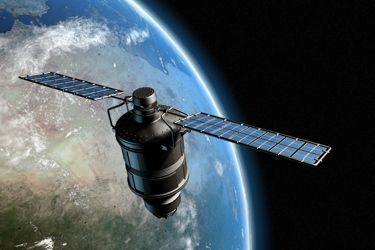Inside Europe's Biggest Test Chamber For Space Antennas

By John Oncea, Editor

Satellites are incredible feats of engineering, and the antennas aboard them are one of their most complex systems which makes producing and testing them demanding and unpredictable. Armed with that understanding – and awareness that the tiniest of variables when building, mounting, or operating an antenna will impact its working performance – led the European Space Agency to collaborate with Danish company TICRA to develop a method of forecasting discrepancies well before construction even begins.
The ESA/TICRA partnership was driven by ESA’s upcoming Biomass mission, designed to deliver crucial information about the state of our forests and how they are changing, as well as further our knowledge of the role forests play in the carbon cycle. Biomass will be carrying the first P-band synthetic aperture radar and is set to launch from Kourou, French Guiana in 2024.
To penetrate the forest canopy, a large wavelength is necessary (around 70 cm) which requires a large antenna of more than 10 m across. The instrument comprises a large deployable reflector with a 12 m diameter projected aperture with an offset feed array and a single beam.
“In the case of Biomass’s antenna, we face a very specific problem,” said ESA antenna engineer Nelson Fonseca. “Because of its sheer size and the signals it employs, it is not feasible to test on Earth. Instead, we predict its in-orbit performance using software modeling.”
“Current antenna simulation tools can only predict nominal performance,” explains Erik Jørgensen, Chief Technology Officer at TICRA. “But when we test the built versions of antennas, we almost never observe nominal performance – there is always a degree of variation.”
To minimize those variations, researchers can run multiple simulations of their antenna in action to see small variations in performance each time, gradually building up a statistical picture of the uncertainty range. “Such bulk simulations are hugely costly in terms of time and computing resources however and provide only very rough approximations – unless you commit to run millions of simulations,” said Oscar Borries, Head of Team Mathematics and AI at TICRA.
The desire to avoid these costs led TICRA to an “uncertainty quantification approach based on ongoing calculations based on a single continuous function that represents the full system performance, rather than a large number of functions that each only represent a small part of the system. The mathematics involved are hugely challenging, but the result is a much more efficient method of quantifying uncertainty.” This approach ultimately led to the ESA/TICRA partnership, something Fonseca called a “win-win.”
Or, You Know, Build A Bigger Test Chamber
Part of ESA’s technical heart, the metal-walled Hybrid European Radio Frequency and Antenna Test Zone (Hertz), is located in the Netherlands, reports Phys.org. It was here that a 5 m diameter transponder antenna, which will operate down on the ground to help calibrate the Biomass mission, was tested.
“This is a particularly challenging test campaign both in terms of the size of the antenna and the very low P-band frequency that Biomass will be using, which allows it to pierce through forest canopies to acquire individual trees,” explains ESA antenna engineer Luis Rolo, overseeing the test campaign. “Usually when we test a large satellite here, its antenna is significantly smaller, typically between 0.5 and 2 meters across. But this entire structure is a radiating antenna in its own right, its sides coming near to the chamber walls.”
As a result, the testing process highlighted some aspects of the chamber never seen before. But engineers came up with a measurement method involving multiple acquisitions from different spots within the chamber, combined carefully to subtract such environmental effects, yielding very accurate results.
The need to test antennas and radio frequency systems as large as those needed for Biomass, along with an understanding that they’re growing larger and more powerful, led ESA to scale up its ground-based test facilities, too,” notes ESA. “A construction project underway beside the dunes of the North Sea marks the expansion of the ESTEC technical center in the Netherlands with the addition of Europe’s largest antenna and radio-frequency payload test chamber – Hertz 2.0.”
The Hertz 2.0 test chamber will be massive: 32 by 25 m in area and 18 m high. This will allow it to “accommodate even the largest entire satellites within an isolated ‘anechoic’ chamber, with metal walls lined with radio-absorbing foam pyramids and carefully-shaped reflectors to mimic the infinite void of space. A dedicated Microwave and Payload Laboratory will be connected to the test chamber, offering complete end-to-end radiated testing capabilities for antennas and payloads.”
Hertz 2.0 isn’t only going to benefit the Biomass mission; it will meet the needs of future ESA and European partner missions as well. Rolo singles out the Galileo Second Generation satellites as an example. “In the case of the first-generation Galileo satellites, radio frequency testing was carried out by separating the payload electronics that generate their navigation signals from the antenna that transmits these signals. But the sophisticated, integrated nature of Galileo Second Generation means that such an approach is no longer possible.
“Instead, we have to test these new satellites as a whole, using a far-field technique capable of handling it all without compromising accuracy. The design of Hertz 2.0 will allow just that: highly accurate end-to-end radiated radio frequency payload performance across a very broad frequency range, to an accuracy that improves the calibration available on the ground and, ultimately, will benefit the quality of the data products and services available to Member States.”
